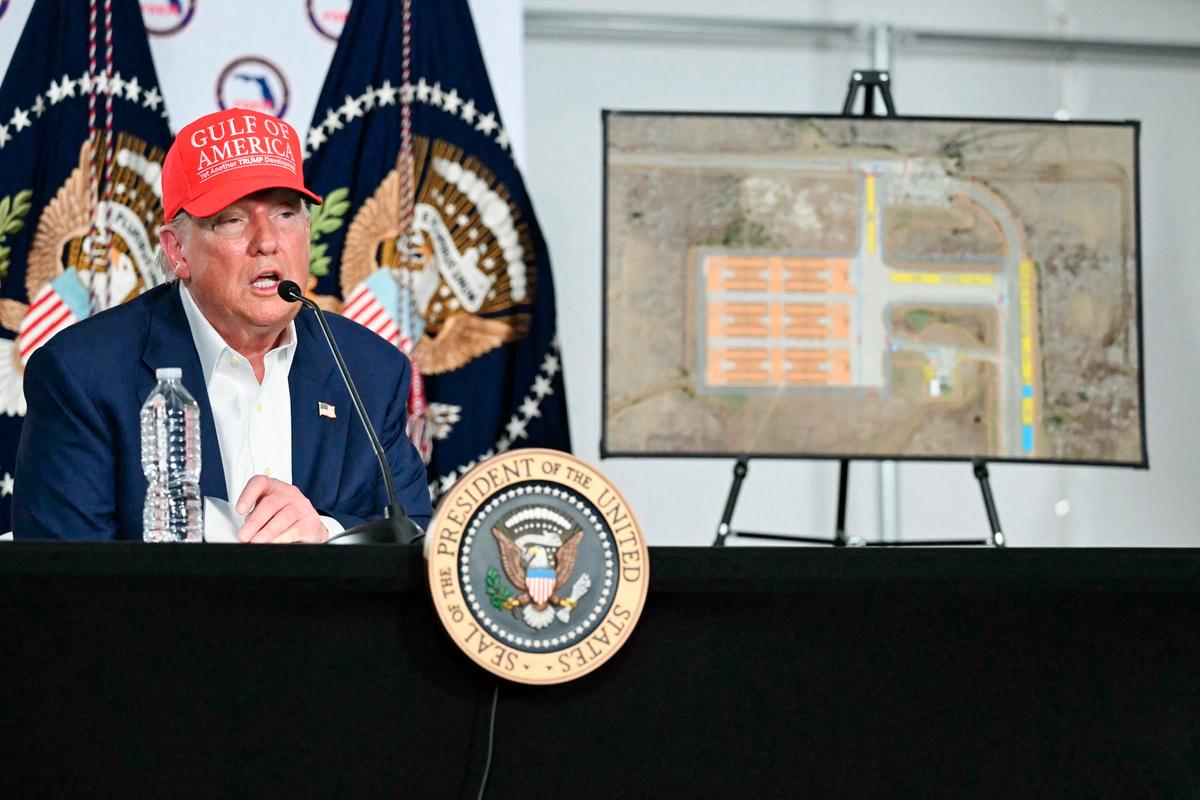By T.J. Muscaro
Deep in the Florida Everglades, the latest illegal immigration detention and deportation facility opened for business on July 1, eight days after state officials said work began.
A cluster of temporary structures large enough to hold up to 3,000 illegal immigrants and 1,000 staff members now stands next to a runway 10,499 feet long and 150 feet wide. The facility was paid for largely by the Department of Homeland Security.
“Think about what you have here,” Florida Gov. Ron DeSantis said during a roundtable at the facility’s opening on July 1. ”They come here, say they have already been ordered to be deported. You drive them 2,000 feet to the runway, and they’re gone.
“It’s a one-stop shop, and this airport that’s been here for a long time is the perfect secure location. It’s going to make a big difference.”

Kevin Guthrie, executive director of Florida’s Division of Emergency Management, celebrated the opening as yet another example of Florida’s “logistical expertise” to rapidly respond to an emergency, adapting what they learned from rebuilding infrastructure after hurricanes to this project.
DeSantis declared a state of emergency regarding illegal immigration earlier this year, granting Guthrie emergency powers to take over the airfield from Miami-Dade County and kickstart the construction.
“There are over 13 different vendors that came together to get this solved in eight days, truly a whole of private sector partnership to get that done,” Guthrie said during the roundtable. ”Behind you on these boards, in only eight days, we have built a fully compliant detention facility with a detainee capacity of up to 3,000 people, with room for additional capacity, if you asked us to do so, the detention includes over 158,000 square feet of housing, and it’s a fully aluminum frame structure rated for winds of 110 miles an hour, or a high-end Category 2.”
The facility is also equipped with a staff village, redundant power systems, air conditioning, the capacity to serve three hot meals a day, a 24/7 medical facility, pharmacy, laundry, legal and clergy support, and indoor and outdoor recreation yards.

Dubbed “Alligator Alcatraz,” the facility is positioned off Highway 41 more than 50 miles west of downtown Miami, surrounded by more than 28,000 feet of barbed wire and more than 10 miles of the Everglades. The facility has more than 400 security personnel, including 200 men and women of the Florida National Guard under the command of Maj. Gen. John Haas, and more than 200 security cameras.
Florida Attorney General James Uthmeier calls it Alligator Alcatraz because of its natural barrier. While San Francisco’s Alcatraz is an actual island the Florida version will be a blacktop island surrounded by a swamp teeming with American alligators and other escape-deterring wildlife.
Officially known as the Dade-Collier Training and Transition Airport, the site was built in the early 1970s within the boundaries of the Big Cypress National Preserve.
According to the National Parks Service, that preserve is home to about 30,000 alligators. There is also a population of American crocodiles, the invasive Burmese pythons—which have been known to eat alligators—venomous native snakes such as the dusky pigmy rattlesnake, eastern diamondback rattlesnake, eastern coral snake, and the Florida cottonmouth, and more than 30 documented Florida panthers. Spiders, mosquitoes, and other insects, as well as varieties of poisonous plants, are also common.

“We like the idea of reopening the original Alcatraz,” Uthmeier said. ”I don’t know if that can happen or not, but we thought, ‘Hey, we’ve got our own natural Alcatraz in the middle of the Everglades, great runway, great, great perimeter. So let’s, let’s make it happen.’”
They were also joined by Secretary of Homeland Security Kristi Noem, who, along with praising Florida’s work, urged illegal immigrants to use the Customs and Border Protection Home App to self-deport back home on the federal government’s dime.
DeSantis affirmed Noem’s offer.
“Why would you want to come through Alligator Alcatraz if you can just go home on your own?” he asked. ”I think a lot of people are going to make that decision.”
Alligator Alcatraz is one of two detention sites opening in Florida, with room for 2,000 illegal immigrants at Camp Blanding, as the Sunshine State seeks to meet its goal of being able to detain 5,000 deportation-bound foreign nationals.
The new site’s rapid development has drawn opposition from several environmentalist groups who have filed suit against it, demanding that it undergo a thorough environmental review required by federal law.
“This project has been rushed through with zero analysis of the impacts of all the vehicles and the thousands of people that will be detained or work on the site,” said co-counselor Alisa Coe of Earthjustice during a press conference on July 1. “There, in addition, has been very little information provided to the public that is contrary to law.”
“The Everglades deserves more, and that’s why we’re in court,” she added.
Plaintiffs expressed their concern for the potential increase in physical pollutants, like trash and sewage, and light and sound pollution, which they argued would negatively affect local wildlife’s breeding and feeding habits, and human visitors’ enjoyment of the preserve’s extremely dark nighttime sky.
They also expressed concern about an increase in animal deaths due to increased road traffic in the area.





